How to Find Your Individual Design Voice
In the design world, volumes have been written advising the newbs, and those with some established street cred, on the ins and outs of being a top shelf designer, and many of these posts will either be focused on or at least include a brief mention of finding your own voice. Your individual style that will give your work that unique and distinctive edge most crave. However, in stark contrast, there is actually very little offered or written on how to achieve this. Only mentions of its importance. Enter this post.
Hopefully this discussion will help you dissect your design approach to find your own voice that lays in wait beneath it. The voice that will aid your work in standing out from the others in the field who have flare and flash, but not individuality. Too often we fall victim to the trends in the community and begin following them without even attempting to make them our own. To inject our own flavor. Because, in all honesty, we have never really given it a try. Schools, businesses, anyone that offers to teach you design tend to only build you a framework, but so many of us forget that we are supposed to fill in the rest.
Here are some tips that we hope will help.
Step 1: Learn the History
Oddly enough, learning the history of the design field is actually taking a step in the right direction. If you want to get a rough and tumble introduction into the ins and outs, ups and downs of the design world, then look into its history. The beginnings of it all, the evolutions of the field and its practices is a fantastic place to gain that insight. Watch as the dominating themes grow and change over the years, shaping the field and pushing its progress.
Taking this sort of grand overview of the entire field and its history is also a great way to see where the field has failed to progress. What areas it needs to have people pushing the envelopes, as it were.
Resources
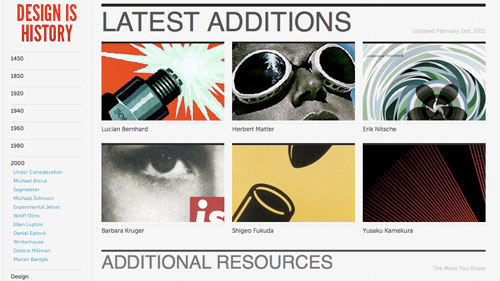
Design is History is a wonderful site to explore the field of design.
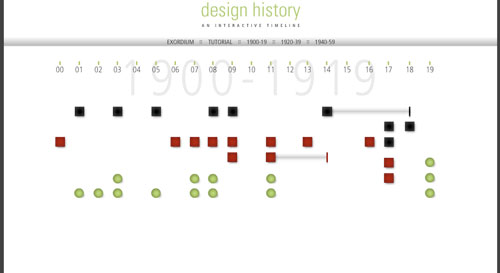
Interactive Design History Timeline is a unique and fun way to get an overview of the design up through the 1950’s.
Step 2: Learn the Basics
The learning doesn’t end there (it actually never does). The basics also need a little attention during this phase of your development. Learn the various design principles and the essential elements that all work together to breathe life into your work. There are fundamental rules that are used to guide the field and that designers are expected to know. And that we are expected to follow, to some extent. Some designers feel like they can skip over the basics, but that is a huge underestimation of all that they can teach you about design.
One of the main lessons that we need to take away from the basics is the communicative properties that these fundamentals possess. When we learn about these building blocks of design, it gives us the ability to use those blocks to their fullest potential regardless of our adherence to all of the underlying rules as we understand them. It effectively empowers us to be able to break the rules that guide our work.
Resources

Principles of Design is an in depth look at the fundamental and guiding principles that govern the field.

The Lost Principles of Design is a useful post from Fuel Your Creativity that examines these design basics.
Step 3: Forget Everything You've Learned
Once we have gotten all of the history and basics down, have learned all of the ways that our designs communicate with the viewers, and have an understanding of the rules, comes a fairly key step in developing a unique style and voice of our own. We have to forget everything that we have learned. Throw out the rulebook that we have been depending on, before it becomes something of a crutch that keeps us from daring into more innovative waters. Don't mistake what we are saying, it is important to have this foundation, or framework in place. But too often we allow these basics to confine our creativity. To limit our potential as it boxes us in.
If we are going to find our own voice in the design world then we have to break out of the box and think for ourselves. The box is comfortable, sure. Full of all of the familiar, but that is not necessarily the way forward. That is more often than not, the way to stagnation as we play it safe. So on this journey we have to first build the framework before we effectively tear it down and rebuild it as we see fit. But without knowing how it all fit together in the first place, we might find it difficult to make it come together for us as we craft our own style.
Resources

CSS Drive Gallery - Unconventional Designs category has a slew of sites that you can check out to see the ways that some have broken out of the box.

Awwwards | The CSS Website Awards is a site dedicated to finding and featuring inspired, original designs.

CSSelite - Unique CSS Gallery is another CSS gallery site with a section that is dedicated to unique styles.
Step 4: Question Everything
Inspiration is a wonderful thing, and is something of a staple of the design process, but we have to remember that when we look at other designs, we need to be dissecting them. Digesting the piece and questioning every aspect and element of it. Design is, for all intents and purposes, strategic and artistic problem solving. Though there are those who might argue with that (especially the artistic part of the equation).
Through a thorough dissection of a design, we can gain a useful understanding of the reasons behind every design choice that was made in a piece. Armed with this knowledge we will be able to craft designs to fit any solution we may need. This will strengthen our design voice, so we should never stop asking questions.
Resources

Dissecting Web Design: The “App” Site is a great example of how we should begin to pick designs apart to find out ways we can learn from them.

Dissecting Web 2.0 Design is another fine example of getting into this questioning frame of mind.
Step 5: Be Weary of Trends
Trends are a powerful force in the design community, and as we set out to find our own voice we need to be able to spot those that we may be drawn to. Though it is not just about being aware of them, as much as it is that we need to beware of them. Trends are fine, and can always be beneficial to play around with and incorporate hints of from time to time. They can open up both our designs and our eyes to techniques and the like that we would have otherwise missed out on. Or worse, dismissed without mining it for potential. So we are not saying that they do not have a place, and one that can be construed as valuable in the web design world.
We just have to be careful is all. If we cannot distinguish the trends from variations on our own style, then we risk never truly being as original as we believe that we are. When we think we are breaking new ground, we are simply treading over areas that have already been covered. It takes some work to make a trend your own, as it were, and to seamlessly blend them into your style, but it can work. There are reasons trends take off, and it is usually because of the somewhat unique solutions they provide. Dissect those trends and connect with the reasons behind them and you are more likely to be able to distill bits of them into your own voice.

Just Google ‘Web Design Trends’ and you will be busy for quite a while
Step 6: Try
It may seem a bit trite, but when it comes to breaking out of the comfort zones and finding our own individual design voice, we cannot be afraid to just try. So often, we allow our fears to hold us back and prevent us from taking risks with our work. But if we never try, then we are certainly never going to find our own unique style. When we design, we should never be afraid to try something different, to explore a previously unheard of route to find the solutions we need. If we think of something to try, no matter how outlandish it may seem, give it a go. We might just find our way to something magical that we would have missed out on otherwise.
It is often hard to find a tale of someone in history who made a name for themselves in their chosen field by sitting on the proverbial benches never daring forward. We cannot be afraid of stepping into new areas and trying new things with our designs, or else we relegate ourselves to a place of near irrelevance. Design is about exploring ideas and finding those solutions that engage and mesmerize. If we cannot find new ways to keep the audiences attention held, then our work is not exactly a success. And often times the best chances we have at drawing them in, is by coming at them in a fresh new way. This tends to mean trying something different.
Resources

Tuts+ Network is a fantastic resource hub for tutorials that can help you gain more confidence in your skills so that you will go for it!

Web Designer Wall is a site where web designers can find some amazing tutorials and some trend info to be on lookout for. Great place to find new techniques and things to try.
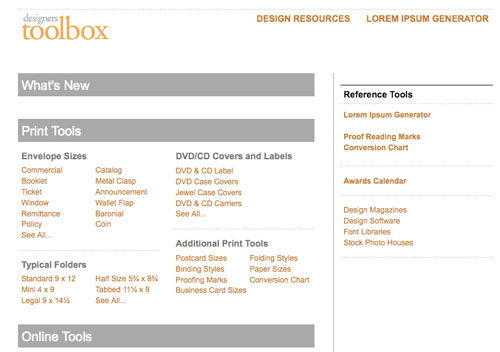
Designers Toolbox is a valuable resource hub for designers of all flavors. When you get ready to try out your skills, this site can hook you up with some of the goods you’ll need.
Step 7: Fail
The biggest reason most of us are afraid to heed the advice just mentioned, is because of that fear we spoke of. That fear is often of failure. Which when you think about it, is really quite silly. For we tend to learn extremely well from our mistakes and our failures. If nothing else, we take away that we have what it takes to keep going and try again. But there is usually more that we end up learning from this failure. We find the incompatibility of certain elements and techniques with particular messages for instance. So failing is not something to be feared, but embraced if we are going to find our own design voice.
One way to think about it is like this. Almost every great feat of innovation that has come about, not just in design, but overall, did not work on the first try. There are often numerous failures that lead up to that one victorious moment of breakthrough. Each failure teaching a valuable lesson along the way. Pushing the innovators forward with each mistake, not setting them back as most would deem it. We also cannot discount the amount of accidental innovation that comes from failure. Wherein we stumble upon entirely new or unrelated ideas to pursue, perhaps for our current project or for a future one. So failing can take our work and style to new heights if we are not afraid of it.
Resource
How Failure Breeds Success is an amazing and inspirational article on the Businessweek Blog with examples of businesses that embraced and learned from their failures.
Step 8: The Criticism Schism
As we explore these new avenues to find a voice that feels right for us, we are going to need to get feedback from the community on our work to make the most of this growth. When the critiques start to come in, we need to recognize when criticism is genuinely constructive, and when it stems from those in the field who disagree with our breaking of the rules and daring off on a path of our own. Understand this will make some people uncomfortable, even feel challenged. Unfortunately, their criticism will generally not be that helpful to us in these cases. So it is vital that we be able to separate the two for your own sake and sanity.
It's human nature, and the design field is subject to its whims just like every field is. When members of the design community, especially those who will always play it safe and by the rules, come across works that step outside the boundaries of what is generally thought of to be acceptable, they have a hard time seeing anything beyond those rules that have been discarded. So any innovation you hoped would engage your audience in a new way, is going to go right over their heads. Their critiques will all, possibly somewhat harshly, be connected to the principles or rules that you ignored. This can help you determine if their critiques are beneficial, or a bit biased.
Resources

21 Resources for Getting Design Feedback is a collection of wonderful places to turn for getting some honest and useful critiques of your work.
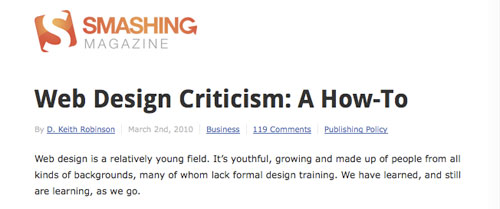
Web Design Criticism: A How-To is one from the old archives here on Smashing that will discusses how to give and in return take criticism of your designs.
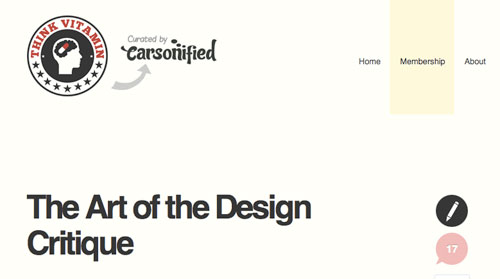
The Art of the Design Critique is another great post that can help with the criticism schism aspect.
In Conclusion
So there are numerous steps that we must take to find our own unique design voice, and each of them are as important to the process as the one that precedes it. If we overlook or underestimate any of them, we undercut our journey to find our style.
Are there any steps that you feel should have been mentioned here that we left out? What was the hardest part of finding your own voice, or if you have not yet, which step do you foresee having the most difficulty with?
(rb)
“Find your own voice” conjures all kinds of mysterious, vague ideas with little direction, doesn’t it? This article finally gives designers some concrete tools to go forth on the mist-enclosed “voice-discovery” journey.
And the crew here would suggest that fresh designers stay patient as they test out ideas, fail, and take criticism. “Finding your voice” means trying out things that might not work for you. Be patient. It’s coming!
Cheers,
Sarah Bauer
Navigator Multimedia
great article, so inspirational, thank you
really helpful and motivating, specially the idea your raise about criticism
thanks a lot
As a designer, your “voice” should be the voice of the client. If everything you design looks like you designed it, you are in trouble. And it’s “be wary”…
Well said!
thanks. now i can really try…along with my classes in the university…all the way from Portugal
I am ‘self-taught,’ so steps 7 and 8 comprise a lot of what I do. Thanks for sharing your wisdom and insights :)